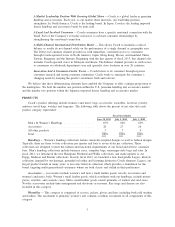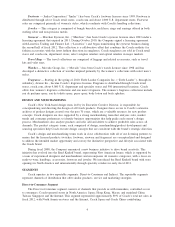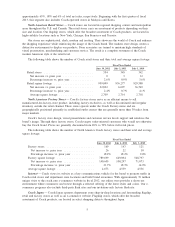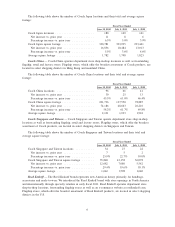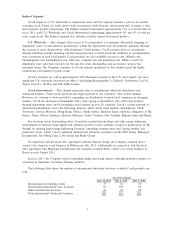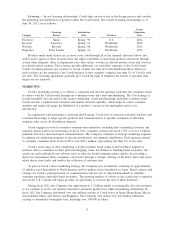Coach 2012 Annual Report Download - page 16
Download and view the complete annual report
Please find page 16 of the 2012 Coach annual report below. You can navigate through the pages in the report by either clicking on the pages listed below, or by using the keyword search tool below to find specific information within the annual report.which could harm our business. Our ability to compete also depends on the strength of our brand, whether we
can attract and retain key talent, and our ability to protect our trademarks and design patents. A failure to
compete effectively could adversely affect our growth and profitability.
We face risks associated with operating in international markets.
We operate on a global basis, with approximately 32% of our net sales coming from operations outside
the U.S. However, sales to our international wholesale customers are denominated in U.S. dollars. While
geographic diversity helps to reduce the Company’s exposure to risks in any one country, we are subject to
risks associated with international operations, including, but not limited to:
• changes in exchange rates for foreign currencies, which may adversely affect the retail prices of our
products, result in decreased international consumer demand, or increase our supply costs in those
markets, with a corresponding negative impact on our gross margin rates,
• political or economic instability or changing macroeconomic conditions in our major markets,
• natural and other disasters in international and other markets, and
• changes in foreign or domestic legal and regulatory requirements resulting in the imposition of new
or more onerous trade restrictions, tariffs, embargoes, exchange or other government controls.
We monitor our global foreign currency exposure and in order to minimize the impact on earnings of
foreign currency rate movements, we hedge our subsidiaries’ U.S. dollar-denominated inventory purchases in
Japan and Canada, as well as Coach’s cross currency denominated intercompany loan portfolio. We cannot
ensure, however, that these hedges will fully offset the impact of foreign currency rate movements.
Additionally, our international subsidiaries primarily use local currencies as the functional currency and
translate their financial results from the local currency to U.S. dollars. If the U.S. dollar strengthens against
these subsidiaries’ foreign currencies, the translation of their foreign currency denominated transactions may
decrease consolidated net sales and profitability.
Failure to adequately protect our intellectual property and curb the sale of counterfeit merchandise could
injure the brand and negatively affect sales.
We believe our trademarks, copyrights, patents, and other intellectual property rights are extremely
important to our success and our competitive position. We devote significant resources to the registration and
protection of our trademarks and to anti-counterfeiting efforts worldwide. In spite of our efforts, counterfeiting
still occurs and if we are unsuccessful in challenging a third-party’s rights related to trademark, copyright, or
patent this could adversely affect our future sales, financial condition, and results of operation. We are
aggressive in pursuing entities involved in the trafficking and sale of counterfeit merchandise through legal
action or other appropriate measures. We cannot guarantee that the actions we have taken to curb
counterfeiting and protect our intellectual property will be adequate to prevent to protect the brand and
prevent counterfeiting in the future. Furthermore, our efforts to enforce our intellectual property rights are
often met with defenses and counterclaims attacking the validity and enforceability of our intellectual property
rights. Unplanned increases in legal fees and other costs associates with defending our intellectual property
rights could result in higher operating expenses. Finally, many countries’ laws do not protect intellectual
property rights to the same degree as US laws.
Cyber security threats, including a privacy or data security breach, could damage our relationships with
our customers, harm our reputation, expose us to litigation and adversely affect our business.
We depend on digital technologies for the successful operation of our business, including corporate email
communications to and from employees and stores, the design, manufacture and distribution of our finished
goods, digital marketing efforts, collection and retention of customer data, employee information, the
processing of credit card transactions, online e-commerce activities and our interaction with the public in the
social media space. The possibility of a cyber-attack on any one or all of these systems is a serious threat. As
part of our business model, we collect, retain, and transmit confidential information over public networks. In
addition to our own databases, we use third party service providers to store, process and transmit this
information on our behalf. Although we contractually require these service providers to implement and use
13


